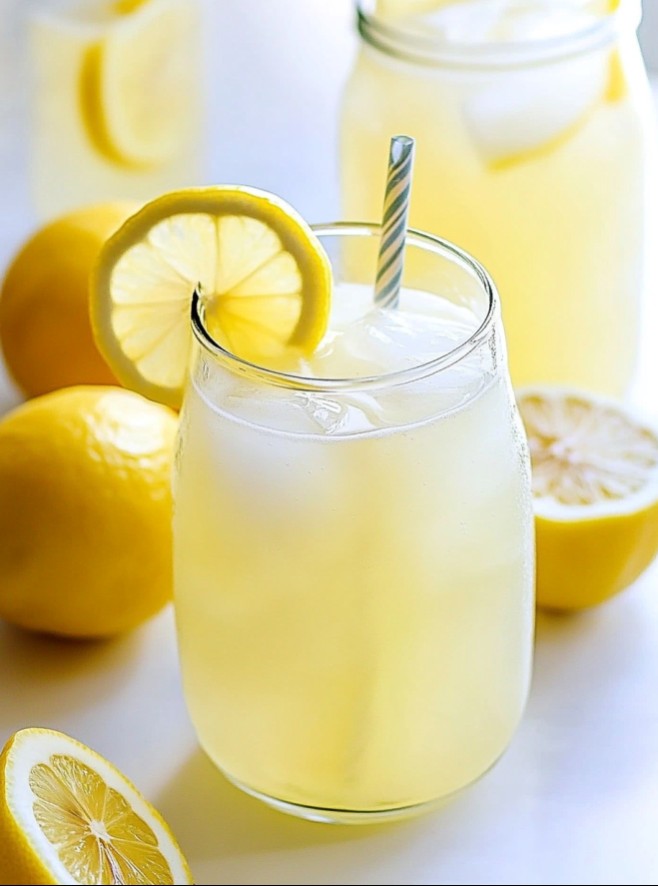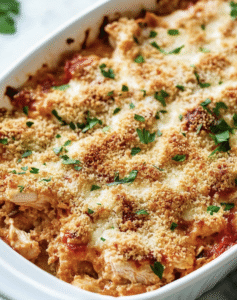There’s nothing more satisfying than a tall glass of ice-cold, homemade lemonade on a warm day. This recipe guides you through creating a perfectly balanced, zesty, and sweet lemonade from scratch. By making a simple syrup, you’ll ensure a smooth, consistently sweet drink with no gritty sugar at the bottom.
- Cuisine: American
- Prep Time: 10 minutes
- Cook Time: 5 minutes
- Total Time: 15 minutes
- Servings: 8
Here’s a great video that shows the process of making a homemade lemonade.
Why You’ll Love This Recipe
- Incredibly Fresh Flavor: Using fresh-squeezed lemons provides a vibrant, zesty taste that powdered mixes can’t replicate.
- Perfectly Sweetened: The simple syrup method ensures the sugar dissolves completely, giving you a smooth texture and consistent sweetness in every sip.
- Fully Customizable: You are in complete control. Easily adjust the sweetness or tartness to match your personal preference.
- Simple, Natural Ingredients: With just lemons, sugar, and water, you can create a delicious beverage free from artificial additives and preservatives.
- Quick and Easy: This recipe is straightforward and fast, making it perfect for last-minute gatherings or a spontaneous sunny-day treat.

Ingredients
- 1 ¾ cups Granulated Sugar: This is the classic sweetener. It dissolves perfectly into the simple syrup for a smooth finish. You can adjust the amount to make it more or less sweet.
- 8 cups Water, divided: You’ll use 1 cup of water to make the simple syrup and 7 cups of cold water to dilute the lemonade. Using filtered water can lead to a cleaner taste.
- 1 ½ cups Freshly Squeezed Lemon Juice: This is the star of the show. You will need approximately 8 to 10 medium-sized, juicy lemons.
- Ice Cubes: For serving and ensuring your lemonade is perfectly chilled.
-
Optional Garnishes: Fresh lemon slices or mint sprigs for a beautiful presentation.
How to Make It
Step 1: Prepare the Simple Syrup
The secret to perfectly smooth lemonade is to make a simple syrup first. In a small saucepan, combine the 1 ¾ cups of sugar and 1 cup of water. Place the saucepan over medium heat. Stir continuously until the sugar has completely dissolved and the liquid is clear. Once dissolved, remove the saucepan from the heat and set it aside to cool slightly. This step prevents any grainy texture in your final drink.
Step 2: Juice the Lemons
While the syrup is cooling, it’s time to juice your lemons. Pro Tip: To get the most juice out of your lemons, make sure they are at room temperature. Firmly roll each lemon on your countertop before cutting and juicing. Cut the lemons in half and squeeze them until you have 1 ½ cups of juice. If you prefer your lemonade without pulp, you can pour the juice through a fine-mesh strainer.
Step 3: Combine and Mix Your Lemonade
In a large pitcher, pour the 7 cups of ice-cold water. Add your freshly squeezed lemon juice and the cooled simple syrup. Stir everything together thoroughly with a long-handled spoon until well combined.
Step 4: Taste and Chill
Give your lemonade a taste. This is the perfect moment to adjust it to your liking. If it’s too tart, add a little more simple syrup. If it’s too sweet, add a splash more lemon juice or cold water. For the best flavor, chill the lemonade in the refrigerator for at least 30 minutes before serving.
Step 5: Serve and Enjoy
Fill your serving glasses with plenty of ice cubes. Pour the chilled lemonade over the ice. For an extra touch of elegance, garnish each glass with a fresh slice of lemon or a sprig of mint. Serve immediately and enjoy the refreshing taste!
Fun Flavor Variations
- Strawberry or Raspberry Lemonade: Blend 1-2 cups of fresh or frozen berries until smooth. Strain the puree through a sieve to remove seeds and stir the fruit juice into your finished lemonade.
- Sparkling Lemonade: For a bubbly twist, substitute half of the cold water with sparkling water or club soda. Add it just before serving to maintain the fizz.
- Herbal Infusion: Add fresh mint, basil, or rosemary to your simple syrup while it’s heating up. Let the herbs steep for a few minutes before straining them out for a sophisticated flavor.
- Watermelon Lemonade: Purée fresh watermelon chunks and strain the juice. Mix this fresh juice into your lemonade for the ultimate summer drink.
Recipe FAQs
How many lemons do I need for 1 ½ cups of juice?
Typically, you’ll need between 8 to 10 medium-sized lemons or 6 to 8 large lemons to get 1 ½ cups of juice.
Can I use bottled lemon juice?
For the best, most vibrant flavor, freshly squeezed lemon juice is highly recommended. However, in a pinch, you can use bottled lemon juice.
How can I make the lemonade less sweet?
You can easily adjust the sweetness by reducing the amount of sugar in your simple syrup. Start with 1 to 1 ¼ cups of sugar and add more to taste if needed.
Can I use a different sweetener?
Yes, you can substitute sugar with honey or agave nectar. Start with about ½ to ¾ cup of honey or agave in your simple syrup, as they are often sweeter than granulated sugar, and adjust to your taste.

Refreshing Homemade Lemonade
Ingredients
- 1 ¾ cup Granulated Sugar
- 8 cup Water
- 1 ½ cup Freshly Squeezed Lemon Juice
- Ice Cubes
- Fresh Lemon Slices Optional for garnish.
Instructions
- The secret to perfectly smooth lemonade is to make a simple syrup first. In a small saucepan, combine the 1 ¾ cups of sugar and 1 cup of water. Place the saucepan over medium heat. Stir continuously until the sugar has completely dissolved and the liquid is clear. Once dissolved, remove the saucepan from the heat and set it aside to cool slightly. This step prevents any grainy texture in your final drink.
- While the syrup is cooling, it's time to juice your lemons. Pro Tip: To get the most juice out of your lemons, make sure they are at room temperature. Firmly roll each lemon on your countertop before cutting and juicing. Cut the lemons in half and squeeze them until you have 1 ½ cups of juice. If you prefer your lemonade without pulp, you can pour the juice through a fine-mesh strainer.
- In a large pitcher, pour the 7 cups of ice-cold water. Add your freshly squeezed lemon juice and the cooled simple syrup. Stir everything together thoroughly with a long-handled spoon until well combined.
- Give your lemonade a taste. This is the perfect moment to adjust it to your liking. If it's too tart, add a little more simple syrup. If it's too sweet, add a splash more lemon juice or cold water. For the best flavor, chill the lemonade in the refrigerator for at least 30 minutes before serving.
- Fill your serving glasses with plenty of ice cubes. Pour the chilled lemonade over the ice. For an extra touch of elegance, garnish each glass with a fresh slice of lemon or a sprig of mint. Serve immediately and enjoy the refreshing taste!
Notes
- Strawberry or Raspberry Lemonade: Blend 1-2 cups of fresh or frozen berries until smooth. Strain the puree through a sieve to remove seeds and stir the fruit juice into your finished lemonade.
- Sparkling Lemonade: For a bubbly twist, substitute half of the cold water with sparkling water or club soda. Add it just before serving to maintain the fizz.
- Herbal Infusion: Add fresh mint, basil, or rosemary to your simple syrup while it’s heating up. Let the herbs steep for a few minutes before straining them out for a sophisticated flavor.
- Watermelon Lemonade: Purée fresh watermelon chunks and strain the juice. Mix this fresh juice into your lemonade for the ultimate summer drink.
Save This Recipe! 💌
We'll email this post to you so you can cook it later!







hey Sandra Clare, was wonderin if i can use lime instead of lemon? wanna try something different but not sure if it work the same. thanks!
Lemonade in winter? groundbreaking…
Loving this lemonade recipe! It’s just perfect for my bake sale. Thank you, Sandra!
Can I substitute the sugar for honey or stevia? Looking for a healthier twist!
gonna use this for my next party, looks super easy to make
When life gives Sandra lemons, she makes lemonade and an article. 😄
Is there a way to make this with less sugar? Concerned about the calories.
bet this tastes like every other lemonade out there. nothing special.
Imagine using this recipe to fuel an intergalactic lemonade stand. 🚀
Can’t wait to pair this lemonade with my summer pies. Thanks for sharing, Sandra!
Tried it. It’s just okay, not like it’s rocket science to make lemonade.
This recipe is a hit! Made it for a BBQ and it was gone in minutes. Cheers, Sandra!
Oh, a lemonade recipe. How innovative. Haven’t seen that before.
gonna make this for me and my cats. but not for the cats. lol.
Would this lemonade be suitable for serving at a Dimmsdale Dimmadome event? Quality is key!
This reminds me of the lemonade we used to make in the summer. Brings back memories!
But what if the lemons are genetically modified? Can’t trust anything nowadays.
Lemonade? In this economy? Guess I’ll just be thirsty then.
Oh, this is just delightful! Will be making it for the grandkids this weekend.
Interesting. I’ve read that the pH of lemon can affect the taste significantly. Wonder how this recipe accounts for that.
Adding vodka to this lemonade might just turn it into my new favorite cocktail!
In my day, lemonade didn’t need a recipe. Kids these days…
Could use this lemonade as inspiration for my next art piece. Refreshingly simple.
What do you think about adding some mint or ginger to spice things up? Would love your thoughts, Sandra!
Actually, lemonade has a fascinating history dating back to ancient Egypt. Quite a traditional refreshment.
Good recipe. Thanks.
Excellent lemonade. A hit at gatherings.